Take Charge of Your Diabetes
3. Keeping Track of Your Blood Glucose
- Checking Your Blood Glucose Each Day
- Getting a Summary Lab Test (A1C)
- Having Problems With Low Blood Glucose
- Having Problems with High Blood Glucose
- Taking Care of Yourself When You're Sick
- Managing Your Diabetes at Work, School, and During Travel
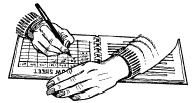 Keep a daily record of your blood glucose levels. |
It’s important to your health to control your blood glucose (also called blood sugar). Keeping your glucose level close to normal helps prevent or delay some diabetes problems, such as eye disease, kidney disease, and nerve damage. One thing that can help you control your glucose level is to keep track of it. You can do this by
- Testing your own glucose a number of times each day (self-monitoring blood glucose). Many people with diabetes test their glucose 2 to 4 times a day.
- Getting an A1C test from your health care provider about every 3 months.
You’ll learn more about these tests on the next pages. These tests can help you and the rest of your diabetes health care team—doctor, diabetes educator, and others—work together to help you control your blood glucose.
Checking Your Blood Glucose Each Day
You can do a test to find out what your blood glucose is at any moment. Your health care team can show you how to do the test yourself. Using a finger prick, you place a drop of blood on a special coated strip, which “reads” your blood glucose. Many people use an electronic meter to get this reading.

Checking your own blood glucose levels is a key to taking charge of
your diabetes.
Blood glucose testing can help you understand how food, physical activity, and diabetes medicine affect your glucose levels. Testing can help you make day-to-day choices about how to balance these things. It can also tell you when your glucose is too low or too high so that you can treat these problems.
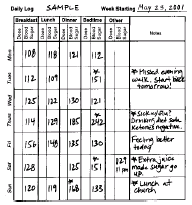 Think of your daily log sheet as a diary for taking charge of your diabetes. |
Ask your health care team to help you set a goal for your glucose range and show you how to record your glucose readings in a logbook or record sheet. If you need a daily logbook, ask your health care provider for one. Or you can make copies of the records page. A sample log sheet is filled out to show you how to use each.
Be sure to write down each glucose reading and the date and time you took it. When you review your records, you can see a pattern of your recent glucose control. Keeping track of your glucose on a day-to-day basis is one of the best ways you can take charge of your diabetes.
Getting a Summary Lab Test (A1C)
By performing an A1C test, health provides can sum up your diabetes control for the past few months. An A1C test measures how much glucose has been sticking to your red blood cells. Since each red blood cell is replaced by a new one every 3 to 4 months, this test tells you how high the glucose levels have been during the life of the cells.
If most of your recent blood glucose readings have been near normal (70 to 140 milligrams per deciliter or mg/dL, with the higher reading mainly after meals), the A1C test will be near normal (usually about 6%–7%). If you’ve had many readings above normal, the extra glucose sticking to your red blood cells will make your A1C test read higher.
You should get an A1C test every 3 months if your test results are not yet at goal. You should get an AIC test at least 2 times a year if your AIC results are at goal. Ask your health care provider for the results and record them on the records page.
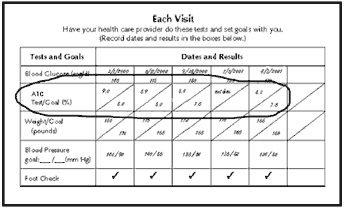 Use your A1C test to track your glucose control. |
Ask your team to tell you the normal range of values and help you set a goal for yourself. Write your goal down on the records page of this guide. If your A1C test results are high, work with your team to adjust your balance of food, physical activity, and diabetes medicine. When your A1C test result is near your goal, you’ll know you’ve balanced things well.
Having Problems With Low Blood Glucose
In general, a blood glucose reading lower than 70 mg/dL is too low. If you take insulin or diabetes pills, you can have low blood glucose (also called hypoglycemia). Low blood glucose is usually caused by eating less or later than usual, being more active than usual, or taking too much diabetes medicine. Drinking beer, wine, or liquor may also cause low blood glucose or make it worse.
Low blood glucose happens more often when you’re trying to keep your glucose level near normal. This is no reason to stop trying to control your diabetes. It just means you have to watch more carefully for low levels. Talk this over with your health care team.
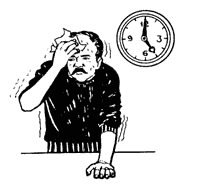
If you have signs that your blood glucose is low but you can't test
right then....
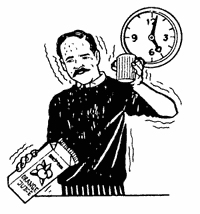
go ahead and treat it!
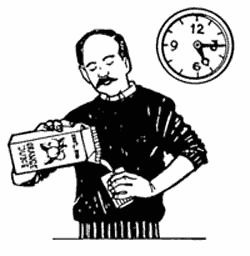
Treat it every 15 minutes, until your glucose level is normal.
Signs of Low Blood Glucose
Some possible signs of low blood glucose are feeling nervous, shaky, or sweaty. Sometimes people just feel tired.
The signs may be mild at first. But a low glucose level can quickly drop much lower if you don’t treat it. When your glucose level is very low, you may get confused, pass out, or have seizures.
If you have any signs that your glucose may be low, test it right away. If it’s less than 60 to 70 mg/dL, you need to treat it right away. See below for ways to treat low blood glucose.
Treating Low Blood Glucose
If you feel like your blood glucose is getting too low but you can’t test it right then, play it safe—go ahead and treat it. Eat 10 to 15 grams of carbohydrate right away. See the box below for examples of foods and liquids with this amount of carbohydrate.
| Food Item | Amount |
|---|---|
| Sugar Packets | 2 to 3 |
| Fruit Juice | 1/2 cup (4 ounces) |
| Soda Pop (not diet) |
1/2 cup (4 ounces) |
| Hard Candy | 3 to 5 pieces |
| Sugar or Honey | 4 teaspoons |
| Glucose tablets | 3 to 4 |
Check your blood glucose again in 15 minutes. Eat another 10 to 15 grams of carbohydrate every 15 minutes until your blood glucose is above 70 mg/dL.
Eating or drinking an item from the list on this page will keep your glucose up for only about 30 minutes. So if your next planned meal or snack is more than 30 minutes away, you should go ahead and eat something like crackers and a tablespoon of peanut butter.
 Write in your logbook why you had a low blood glucose level. |
In your glucose logbook or record sheet, write down the numbers and the times when low levels happen. Think about what may be causing them. If you think you know the reason, write it beside the numbers you recorded. You may need to call your health care provider to talk about changing your diet, activity, or diabetes medicine.
Tell family members, close friends, teachers, and people at work that you have diabetes. Tell them how to know when your blood glucose is low. Show them what to do if you can’t treat yourself. Someone will need to give you fruit juice, soda pop (not diet), or sugar.
If you can’t swallow, someone will need to give you a shot of glucagon and call for help. Glucagon is a prescription medicine that raises the blood glucose and is injected like insulin. If you take insulin, you should have a glucagon kit handy. Teach family members, roommates, and friends when and how to use it.
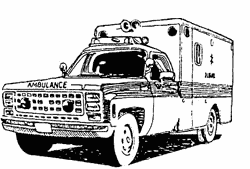 In a low blood glucose emergency, you may need to go to the hospital. |
Waiting to treat low blood glucose is not safe. You may be in danger of passing out. If you get confused, pass out, or have a seizure, you need emergency help. Don’t try to drive yourself to get help. Be prepared for an emergency.
Preventing Low Blood Glucose
Keep a balance
Try to stay close to your usual schedule of eating, activity, and medicine. If you’re late getting a meal or if you’re more active than usual, you may need an extra snack. See Managing Your Diabetes at Work, School, and in Travel for more ideas about managing your diabetes.
Check your blood glucose
Keeping track of your blood glucose is a good way to know when it tends to run low. Show your logbook or record sheet to your health care providers. Be sure to let them know if you’re having a number of low glucose readings a week.
To be safe, always check your glucose before doing any of these things:
- Driving a vehicle.
- Using heavy equipment.
- Being very physically active.
- Being active for a long time.
Ask your health care team whether you should test your glucose before (or during) any other activities.
 Always carry along some food with carbohydrates in it. |
Be prepared
Always carry some type of carbohydrate sugar food or drink with you so you’ll be ready at any time to treat a low glucose level. See the table "Foods and Liquids for Low Blood Glucose" for snacks that have 10–15 grams of carbohydrate.
Always wear something (like an identification bracelet) that says you have diabetes. Carry a card in your wallet that says you have diabetes and tells if you use medicine to treat it.

Wear something that lets others know you have diabetes, in case of
an emergency.
Having Problems with High Blood Glucose
For most people, blood glucose levels that stay higher than 140 mg/dL (before meals) are too high. Talk with your health care team about the glucose range that is best for you.
Eating too much food, being less active than usual, or taking too little diabetes medicine are some common reasons for high blood glucose (or hyperglycemia). Your blood glucose can also go up when you’re sick or under stress.
Over time, high blood glucose can damage body organs. For this reason, many people with diabetes try to keep their blood glucose in control as much as they can.
Some people with type 2 diabetes may not feel the signs of high blood glucose until their blood glucose is higher than 300. People with blood glucose higher than 300 are more likely to have dehydration. Dehydration can become a serious problem if not treated right away.
Your blood glucose is more likely to go up when you’re sick—for example, when you have the flu or an infection. You’ll need to take special care of yourself during these times. The Taking Care of Yourself When You're Sick can help you do this.
Signs of High Blood Glucose
 Frequent urination can be a sign of high blood sugar. |
Some common signs of high blood glucose are having a dry mouth, being thirsty, and urinating often. Other signs include feeling tired, having blurred vision, and losing weight without trying. If your glucose is very high, you may have stomach pain, feel sick to your stomach, or even throw up. This is an emergency and you need to go to the hospital right away.
If you have any signs that your blood glucose is high, check your blood. In your logbook or on your record sheet, write down your glucose reading and the time you did the test. If your glucose is high, think about what could have caused it to go up. If you think you know of something, write this down beside your glucose reading.
Preventing High Blood Glucose
 Balance is the key to taking charge of your diabetes. |
Keep a balance
Try to stay with your food and activity plan as much as you can. Drink water. Take your diabetes medicine about the same time each day. Work with your health care team to set goals for weight, blood glucose level, and activity.
Test your blood glucose
Keep track of your blood glucose and go over your records often. You’ll learn how certain foods or activities affect your glucose.
Show your records to your health care team. Ask how you can change your food, activity, and medicine to avoid or treat high blood glucose. Ask when you should call for help.
Taking Care of Yourself When You're Sick
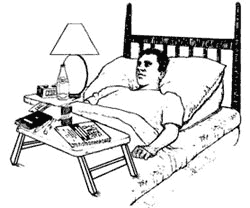
You’ll need to take special care of yourself when you’re sick. The tips that follow can help you do this.
Keep Taking Medicine
Be sure to keep taking your diabetes pills or insulin. Don’t stop taking them even if you can’t eat. Your health care provider may even advise you to take more insulin during sickness.
Keep Eating
Try to eat the same amount of fruits and breads as usual. If you can, eat your regular diet. If you’re having trouble doing this, use carbohydrate choices or servings: eat enough soft foods or drink enough liquids to take the place of the fruits and breads you usually eat.
Drink Liquids
 Be sure to drink extra fluids when you're sick. |
Drink extra liquids. Try to drink at least 1/2 cup (4 ounces) to 3/4 cup (6 ounces) every half-hour to hour, even if you have to do this in small sips. These liquids should not have calories. Water, diet soda pop, or tea without sugar are good choices.
Check for Changes
- Weigh yourself every day. Losing weight without trying is a sign of high blood glucose.
- Check your temperature every morning and evening. A fever may be a sign of infection.
- Every 4 to 6 hours, check how you’re breathing and decide how alert you feel. Having trouble breathing, feeling more sleepy than usual, or not thinking clearly can be danger signs.
Keep Records
Use "Records for Sick Days" Ask a family member or friend to help if you need it.
Call for Help
Ask your health care provider when you should call. During your sick
times, you may need to call every day for advice.
You should call your health care provider or go to an emergency room if any of the following happens:
You may need to call your doctor daily when you're sick.
- You feel too sick to eat normally and for more than 6 hours can’t keep food or liquids down.
- You have severe diarrhea (loose bowel movement).
- You lose 5 pounds or more without trying to.
- Your temperature is over 101°F.
- Your blood glucose level is lower than 60 mg/dL or stays over 300 mg/dL.
- You’re having trouble breathing.
- You feel sleepy or can’t think clearly.
Managing Your Diabetes at Work, School, and During Travel
Staying in charge of your diabetes no matter what your day holds—work, school, travel, or special events—takes planning ahead. Many days will go smoothly, but some days will hold surprises, such as extra activity or delays that throw your schedule off.

Stay in charge of your diabetes—no matter what your day holds—by
planning ahead.
Plan ahead for these times by always keeping a treatment for low blood glucose with you (see Foods and Liquids for Low Blood Glucose for some choices). If you have any signs that your glucose may be low (see Signs of Low Blood Glucose), go ahead and treat it right away.
Stay as close to your eating, activity, and medicine schedule as you can. Keep track of your blood glucose so you can pick up changes early. Always wear or carry identification that says you have diabetes.
Talk with your health care team about your planned schedule and activities. Ask for help in planning ahead for work, school, travel, and special events. When you read the rest of this section, you may think of more questions to ask.
At Work and School
 Talk with your health care provider about balancing your daily activities and your glucose levels. |
Talk with your health care team about the type of activity you do at work or at school. From time to time, you and your health care team may need to make changes in your activity, medicine, or eating.
Many people take supplies for checking their glucose to school or work so they can check if at regular break times. Some people choose to show their fellow workers, their teachers, or their classmates how to help if they should ever have a problem. They teach them how to tell when their glucose is low and how to treat it (see Treating Low Blood Glucose). Some people like to have written steps on file at their place of work or with their teacher.
During Travel
 Trips can hold surprises. Plan ahead for delays and changes. |
When you plan a trip, think about your day-to-day schedule and try to stay as close to it as you can. For example, if you usually check your blood glucose at noon and then eat lunch, plan to do this on your trip, as well. Trips can hold surprises—in delays and changes. Even the types of food and supplies you can buy on your trip may not be the same as those you get at home.
Before you travel, work with your health care provider to plan your timing for medicine, food, and activity. Talk about what to do if you find changes in your glucose readings.
Plan ahead for trips:
- Keep snacks with you that could be used to prevent—or treat—low blood glucose.
- Carry extra food and drink supplies with you, such as cracker packs and small cans of juices or bottled water.
- Carry glucose testing supplies with you.
- Take along all the diabetes medicine you’ll need. Keep medicines in
the original pharmacy container with the printed label that clearly
identifies the medicine.
When you travel, be sure to
- Test your glucose often and keep track of it.
- Wear identification that says you have diabetes.
- Let others know how they can help you.
- Check new airline travel tips by contacting the Federal Aviation
Administration (FAA) at http://www.faa.gov
or 800-322-7873.
If you’re traveling in a different time zone, you may need to change your timing of food, medicine, and activity. Ask your health care provider to help you with this. Talk about the food and drink choices that would be healthy for you. If you’ll be in another country, ask your doctor to write a letter explaining that you have diabetes. It’s also a good idea to get your doctor to write a prescription for you to get insulin or supplies if needed.

No matter where you travel, you can take charge of your diabetes.
Return to Table of Contents
Contact Us:
- CDC Diabetes Public Inquiries
- 800-CDC-INFO
(800-232-4636)
TTY: (888) 232-6348
8am-8pm ET
Monday-Friday
Closed Holidays - cdcinfo@cdc.gov



